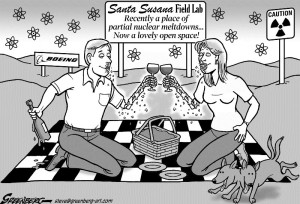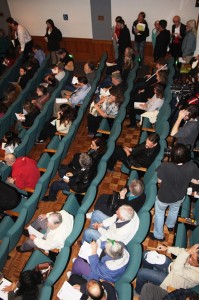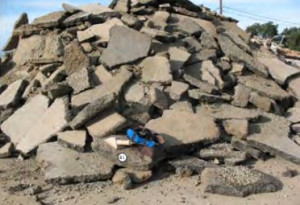

PART TWO – GLOW IN THE DARK PARK
Agency commitments to SSFL cleanup, radioactive debris, and Runkle Canyon dust cause a stir at SSFL Work Group meeting
News & Analysis
The Santa Susana Field Laboratory Work Group February 5 in Simi Valley gave community members a chance to learn more about the details and progress of current cleanup agreements for the polluted former nuclear and rocket testing facility. SSFL sits in the hills between the Simi and San Fernando valleys and operated for over half a century beginning in the late 1940s.
Dan Hirsch, president of the nuclear watch-dog group Committee to Bridge the Gap, presented on the Agreements on Consent that NASA and the Department of Energy (DOE) signed with the California Department of Toxic Substances Control (DTSC) in 2010 to clean up their portions of SSFL to background levels of contamination.
Hirsch explained the agreement in simple terms, “What they contaminated, they will clean up, if they can find it. If it’s at a level below a detection limit, they don’t have to cleanup what they can’t detect.” He noted that the AOC includes in situ [in place] treatment as an option for remediating contaminated soil, and that the agreement includes exceptions for endangered species and Native American artifacts. In closing, Hirsch noted that some community members had gotten nervous that the agencies may be trying to break the cleanup commitments, and that there might not be any cleanup at all.
John Jones, DOE federal project director for SSFL, gave a short presentation that seemed to allay such fears.
“At the end of the day, our perspective is that it’s what Dan [Hirsch] had mentioned, it was [former DOE assistant secretary for environmental cleanup] Inéz Triay that said ‘I’m tired of fighting. Let’s clean up to background,’” Jones told the crowd. “Let’s get this site closed. And that is what has led to where we’re at…The bottom line is yes things happen, yes they were unfortunate and we’ve made a commitment to clean it up.”
Jones told the Work Group audience that the agency was committed to the AOC it signed because, “At the end of the day…it’s the right thing to do.”
The very next night, however, Jones hosted a DOE Soils Treatability Investigation Group (STIG) meeting at the Radisson Hotel in Chatsworth, at which he said that 1,700,000 cubic yards of soil would have to be removed from the DOE area, according to one attendee. Jones also claimed that a bag of dirt he bought from the store would have to be cleaned up if AOC levels were employed. That must have been some monstrously hot dirt, given the already high look up tables for radiological trigger levels. More likely, it is a ploy intended to misinform and alarm the community.
Jones’s stunt indicates that DOE is anything but as enthusiastic as he portrayed at the Work Group meeting to meaningfully remediate Area IV. Two subsequent public scoping hearings (covered in upcoming EnviroReporter.com reporting) also demonstrated that DOE’s commitment to the AOC may in fact have been an empty promise.
 Following Jones at Work Group event was NASA’s Peter Zorba, SSFL project manager for the space agency. Zorba described activities NASA had taken to date in preparing its Environmental Impact Statement (EIS), estimating that upwards of 480,000 to 500,000 cubic yards of soil had been fouled by half a century’s 30,000 rocket engine tests.
Following Jones at Work Group event was NASA’s Peter Zorba, SSFL project manager for the space agency. Zorba described activities NASA had taken to date in preparing its Environmental Impact Statement (EIS), estimating that upwards of 480,000 to 500,000 cubic yards of soil had been fouled by half a century’s 30,000 rocket engine tests.
Zorba made no clear commitment to the AOC, prompting Hirsch to play a videotape of NASA associate administrator Richard Keegan telling Congresswoman Julia Brownley (D- Thousand Oaks) that NASA was committed to the AOC, despite a previous Inspector General report stating the cleanup was too costly. With prodding from Hirsch, Zorba indicated that NASA remained committed. Hirsch responded, “We’ll see what happens in March,” referring to the release of NASA’s final Environmental Impact Statement (EIS), due out this month.
DTSC’s Ray Leclerc, department project director for SSFL, was much more direct. “We are committed to the AOCs and as necessary, we will enforce the AOCs,” he said to cheers and applause.
“I do probably want to reiterate that we intend to implement CEQA,” continued Leclerc. “It’s the law but we also intend to enforce the AOCs and they are wholly consistent. We’ve heard some comments that some people may believe they are inconsistent; they’re not. CEQA’s the law and the AOCs and we intend to enforce them. It’s as simple as that.”
But DTSC’s true designs may also not be so simple, as evidenced by a February 24 email it sent out. “On Wednesday, April 9, 2014, the Department of Toxic Substances Control (DTSC) will host their next biannual public meeting,” the email read. “Staff from the Department of Toxic Substances Control will discuss the potential off-site risks associated with the cleanup of the Santa Susana Field Laboratory (SSFL) site.” [Emphasis added]
DTSC has repeatedly denied the off-site contamination from SSFL poses a risk to public health, despite numerous instances of hazardous SSFL contaminants found in nearby Runkle Canyon, Sage Ranch, Brandeis-Bardin and Dayton Canyon. [KB Home’s Runkle Canyon development is now called Arroyo Vista at the Woodlands.]
But now, the department will host a meeting about the risks to the public from the cleanup, a topic that seems to be aimed squarely at creating concerns that the clean up – not the contamination – is the problem, a move which calls into question the sincerity of it’s previously avowed commitment to the cleanup agreements.
Radioactive Break Down
The final Work Group presentation of the evening was made by Ethan Miska, a student at UC Santa Cruz. Miska assisted Hirsch in producing the report, “Demolition of Radioactive Structures and the Disposal and Recycling of the Debris from the Santa Susana Field Laboratory Nuclear Area and the Role played by the California Department of Toxic Substances Control and the California Department of Public Health.”
Despite the lengthy name, the presentation shortly elucidated gasps of incredulity from the audience. It was easy to see why. Miska’s presentation showed radioactive Area IV buildings being torn down by Boeing with tons of irradiated metal being sent to recyclers and even more sent to dumps not designed for radioactive waste. And all of it approved by looking the other way by DTSC and CDPH, or DPH as it is referred to in court documents.
Recycled radioactive metal is not a new issue but it is a potentially life and death dispersion of lethal radionuclides into the consumer product stream unbeknownst to the purchaser. It certainly is a lot cheaper than disposing of radioactive metal, concrete and other debris in a licensed radioactive dump.
“Virtually anything from utensils, pants zippers, teeth braces, belt buckles, hip and the drive shafts of automobiles were being made out of radioactive recycled metal that originated from government contracted facilities,” according to a Pasadena Weekly newspaper article by this reporter in 2001. “[Committee to Bridge the Gap] uncovered the problem when it discovered that 300 tons of radioactive metals had been sold to a San Pedro, California recycler by military industrial giant Rocketdyne.”
 Now Boeing, which bought the majority of SSFL in 1996, has been caught doing the same thing again only this time, the numbers are even more staggering. Over 1,150 tons of radioactive waste was dumped in Class One landfills designed for chemical, not radioactive, disposal. About 568 tons of rad waste generated by Boeing during the teardowns and structural excavations went to Class Two industrial dumps also not used for radiation debris. So pervasive was this dumping that 242 tons ended up in Southern California municipal dumps.
Now Boeing, which bought the majority of SSFL in 1996, has been caught doing the same thing again only this time, the numbers are even more staggering. Over 1,150 tons of radioactive waste was dumped in Class One landfills designed for chemical, not radioactive, disposal. About 568 tons of rad waste generated by Boeing during the teardowns and structural excavations went to Class Two industrial dumps also not used for radiation debris. So pervasive was this dumping that 242 tons ended up in Southern California municipal dumps.
Even more was recycled. Nearly 500 tons of metal were recycled into the commercial metal product stream. Over 2,400 tons of concrete and asphalt were recycled. That’s a lot of metal for kids’ braces and asphalt and concrete for them to play on sidewalks and at playgrounds.
A preliminary injunction against DTSC and the DPH for allowing the building demolition to take place without California Environmental Quality Act (CEQA) review was granted and ordered December 11, 2013. “Petitioners contend the buildings remain contaminated with unacceptably high levels of radiation; demolition will release that radiation; release of radiation could harm the public and environment; and further harm to the public and environment could result if the debris is not disposed of in a facility licensed to receive low-level radioactive waste,” the order read. “Petitioners allege DTSC and DPH approved Boeing’s demolition and disposal activities without performing the environmental review required by CEQA.”
These are no ordinary buildings. They are some of the hottest of the hot in a place that had three partial meltdowns, a hot lab and a burning pool of radioactive sodium across a huge space in the middle of the DOE nuclear complex. It’s no wonder that nuclear workers in Area IV succeeded in getting compensation for the colossal amounts of radioactive contamination that they were exposed to, thanks to the efforts of Work Group panelist Bonnie Klea aka The Atomic Avenger.
Miska showed photos of the torn down buildings which begged credulity that anyone, even Boeing, would think these edifices and foundations could somehow be safe to recycle or dump in municipal landfills. Evidence of unsafe Boeing demolition was exposed by EnviroReporter.com in December 2012 giving good cause for concern over how sloppy the company’s contractors were allowed to be destroying these radiation facilities.
Boeing tore down Area IV Building 4005 which “managed” depleted and enriched uranium, according to multiple reports. The foundations were also dug up. Building 4005 had a hot history of trouble. A uranium fire released smoke throughout the building January 30, 1967 and a concrete pad was irradiated August 8, 1991 when radioactive oil from a hot exhaust duct dripped on it. Now the place has been torn up, recycled or dumped in places not meant for radioactive rubble.












Wow. The report above was a house rocker.
Michael is correct and Dan is correct.
I can only add one point:
DTSC’s employees and management cannot be trusted.
DTSC has a history of approving “dead of night” removals of depleted uranium contaminated soil from the Whittaker Bermite site in Saugus, CA, which served to economically benefit the former property owner, Whittaker Corporation of Simi Valley. The DU contaminated soil had been sitting on the Bermite property for roughly 20 years, held down in large part by a fairly dense brush cover which grew after ammunition testing work at Bermite stopped.
In that circumstance DTSC’s Project Manager approved a contractor hired by Whittaker (a) digging up the DU contaminated soil, (b) placing it in unmarked trucks which were supposed to be covered, but observers said in many cases were not and (c) hauling the DU contaminated soil out of the Santa Clarita Valley in the dead of night, taken through the City of Las Vegas without any notice to that city or the Nevada Highway Patrol and (d) disposed of in Utah.
In planning and approving that process DTSC chose not to notify the public in the Santa Clarita Valley, not to notify the school district whose high school the DU laden trucks were passing, not to formally notify the City of Santa Clarita (other than by whispers in the ear of a friendly city staffer.)
In planning and approving that process, DTSC did not comply with CEQA and moved heaven and earth to keep its plans secret until after the statute of limitations to challenge the plans in court had passed.
In planning and approving that process the DTSC asked for input from the L.A. County Health Department, which sent a list of conditions on the “dig up and drive away” which would have protected the public health…but DTSC just ignored those comments.
The “public” in Santa Clarita noticed when they started seeing a whole lot of tractor trailer lights on the Bermite property at night. Locals couldn’t get DTSC to admit was going on, but California DPH ratted them out after 300 double truck loads of the DU contaminated soil had been hauled away in the dead of night.
The DTSC was unapologetic about what it had done, citing a provision in a 2002 Order it had issued to Whittaker Corporation which said that DTSC could order Whittaker to take action “in an emergency”. Some emergency. The DU contaminated soil had been sitting on the Bermite property for 20 years.
Never trust DTSC employees or managers. Even if DTSC has signed a piece of paper. There’s an old expression “you can’t estop the public, or contract away the police power” which means, in English, that the DTSC can change its mind on any issue, unless some court has issued an order or judgment against them.
Thank you on your excellent reporting.